Johannesburg was built on a gold rush. But in the Isando Campus business park on the outskirts of South Africa’s financial centre, a much more precious substance is being piled up at an even more frenetic pace.
This is the home of Teraco, Africa’s biggest operator of independent data centres — the facilities that make the modern internet go round and house content for the likes of Google, Netflix and telecom companies.
Inside there is a monastic air, with quiet climatically-controlled corridors of racks. But outside is a flurry of construction activity. Clients have only just moved into Teraco’s latest data centre, but the groundwork has already begun on its next one, a 38-megawatt facility a few kilometres away that will be Africa’s largest yet, aiming to entice the world’s top cloud-computing providers.
The biggest sign of change is a surge in traffic in the last year at the facilities of another Teraco asset, NAPAfrica, the continent’s biggest internet exchange point which connects hundreds of African telecoms and content providers.
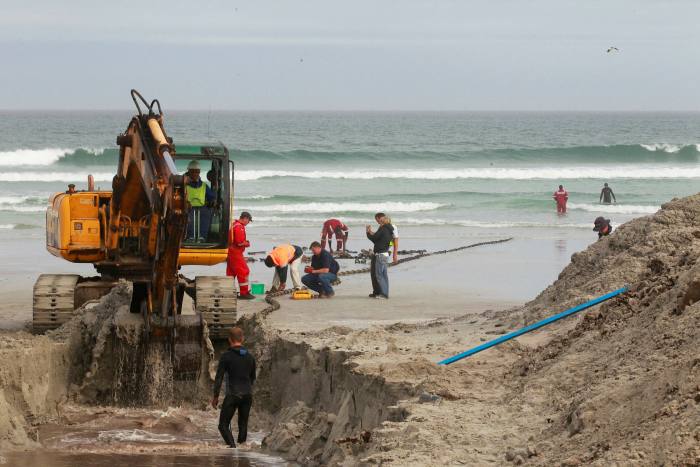
“It is just crazy . . . it has literally exploded,” says Jan Hnizdo, chief executive of Teraco. It took the best part of a decade for NAPAfrica’s peak traffic speed to hit one terabit a second, a milestone reached in March 2020 just as the pandemic struck. Just months later it is now about 1.5 terabits.
Africa’s internet capacity is indeed exploding — becoming faster, denser and more local, which has profound implications for the continent’s economies. It is a shift that has rapidly accelerated because of the coronavirus pandemic and one that is attracting global infrastructure investors.
Another “gold rush” has begun — in Africa’s data, says Guy Zibi, founder of Xalam Analytics, an industry observer. The phrase is “purposely hyperbolic”, but it captures the dramatic expansion in a still-nascent market, he says. “In football terms . . . the first half of the first half.”
A data centre boom is already under way. But global internet companies have also noticed the edge that investing in upgrading Africa’s digital infrastructure could give them in cutting the costs of access to their services in a largely untapped market.
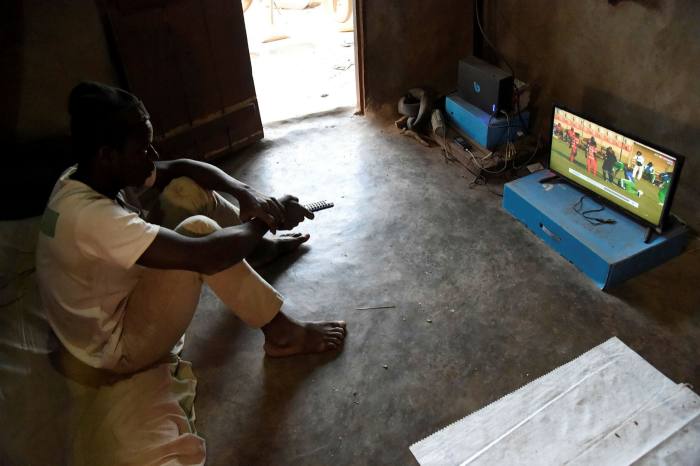
Google and Facebook in particular have been going to extreme lengths — literally. This year Google is due to finish the first phase of laying a subsea internet cable from Lisbon to Cape Town named after the 18th-century African abolitionist, Olaudah Equiano.
Facebook is among backers of the less evocative, but even longer, 37,000km 2Africa cable intended to circumnavigate Africa with the capacity of 180 terabits a second by completion in 2023 or 2024.
Like the rest of the world, pandemic social distancing has led millions of Africans to work online, not least as a second wave recently struck large swaths of the continent.
“What is amazing is how well this digital infrastructure stood up,” says Mr Hnizdo. Even then, many Africans are frustrated by wonky Zoom connections and expensive data top-ups. It reflects how much more infrastructure is still needed.
Less than 1 per cent of the world’s data centre capacity is in Africa, at about 200MW as of last year, according to Xalam Analytics. But the demand is already much more, Mr Zibi adds.
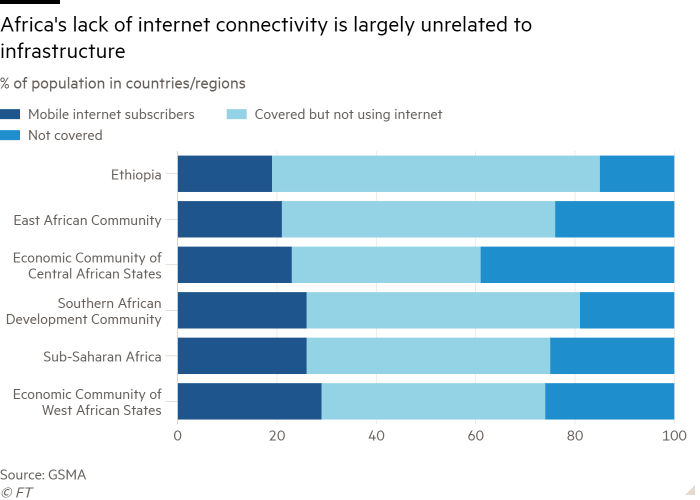
‘Meaningful’ connectivity
Africa is well known as the home of most of the “last billion” worldwide who are yet to be properly connected to the internet. Half of Africans — or just over 500m people — have access to mobile internet coverage but do not use it, according to GSMA, a mobile industry body.
But the numbers of Africans who are connected will grow by 200m to 475m by the middle of the decade, out of 615m mobile subscribers. They are likely to demand more and faster data at lower cost.
According to GSMA forecasts, average African mobile data traffic will more than quadruple to just over 7 gigabytes per month per subscriber. By 2025, nearly 30m 5G connections in Africa are forecast — a drop in the ocean of the 1.7bn predicted worldwide, but a dramatic increase from last year when there were the barely any on the continent.
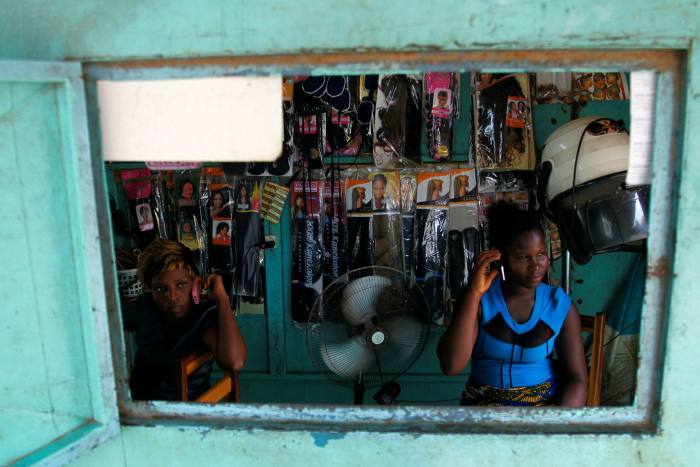
Many projections for African broadband adoption rates still assume 3G connections of under 5 megabits a second, however. “The reality is that it is very difficult to reliably access some of the most fundamental applications on a 5 megabit connection,” says Mr Zibi. It includes the Google Meet software he is using to talk to the Financial Times. The African market must now aim for what the Alliance for an Affordable Internet calls “meaningful” connectivity, or the speeds associated with at least 4G connections, he says.
In December Netflix appointed Strive Masiyiwa, the founder of Liquid Telecom, Africa’s biggest independent fibre operator, to its board. Mr Masiyiwa, Netflix’s first African director, is also backing African Data Centres, another operator, which received $300m from the US International Development Finance Corporation last year.
At home, some of Africa’s most-watched openings to investment this year will add to pressure for better internet plumbing. South African president Cyril Ramaphosa has promised to finish an auction of the transmission signal rights necessary for full 5G rollout early in 2021, after delays that his own Treasury described as a growth bottleneck. In Ethiopia, Abiy Ahmed’s government is pushing ahead with a plan to open up Africa’s last big closed phone market.
This will all need money. Data centres are particularly capital-intensive. Actis, the biggest private equity investor in Africa, has set up a $250m platform to invest in data centres including a stake in Rack Centre, the biggest operator in Nigeria. “This sector needs quite a lot of money to scale up for the needs of end users, cloud customers and others,” says Kabir Chal, an Actis director.
It is the same for other parts of the emerging African ecosystem, from subsea cables to mobile masts. “All of these trends are converging,” Mr Hnizdo says. “Covid really accelerated everything.”
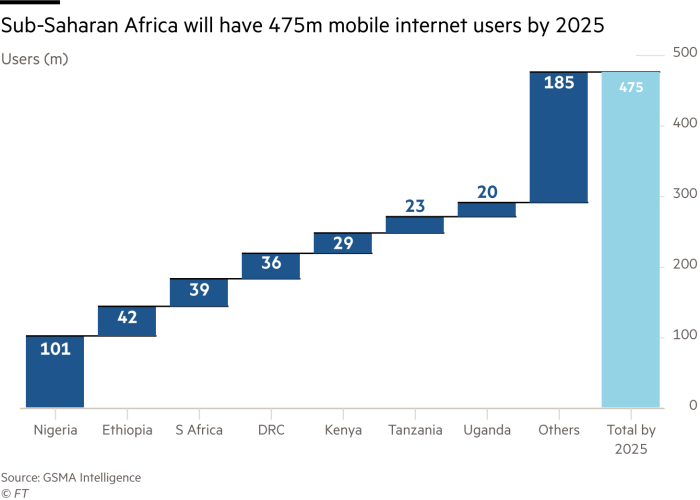
Keeping data local
It is just about possible to blink your eye faster than for a signal to travel through the internet’s cables from Johannesburg to London and back again — about 160-170 milliseconds of latency.
This is increasingly too slow and costly for intensive use of internet resources, such as cloud computing or video streaming — which is why companies such as Netflix are trying to physically position content such as video closer to users in places like Teraco’s facilities. “A [Microsoft] Azure customer in Nairobi wants the same service as an Azure customer in London,” Mr Chal says.
South Africa is well positioned to reduce this latency because its data centres are closer to customers on the continent versus hubs such as London, says Mr Hnizdo.
Latency is driving localisation but data sovereignty is also on the agenda, Mr Zibi says: “There is a lot of concern that a lot of Africa’s data is hosted outside Africa.” That includes banks’ data, as well as that of oil and gas groups and governments.
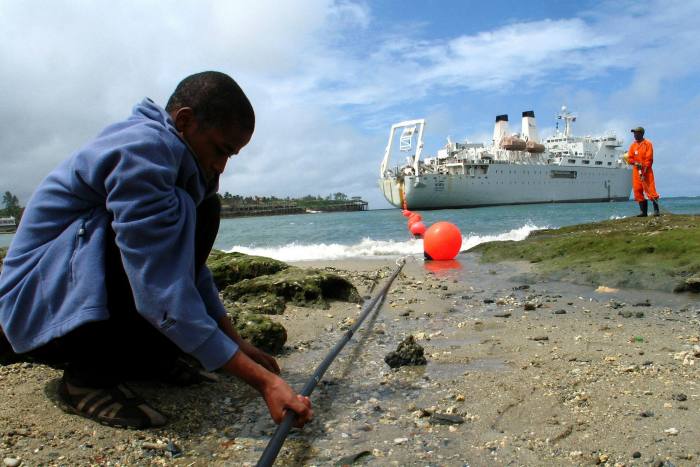
In 2010 the Internet Society set a goal of “Eighty for Africa”, or for four-fifths of continental internet traffic to move within Africa’s borders, rather than having to route through other regions.
A decade later, developments in Kenya and Nigeria point towards this becoming a reality, with the rise of internet exchange points such as NAPAfrica which join local internet providers and direct local traffic. According to an Internet Society report last year, under a third of Kenya and Nigeria’s traffic was local in 2012. It is now 70 per cent.
In that time, the peak internet traffic handled by Nigeria’s internet exchange has risen 400 times, from 0.3 gigabits per second to at least 125Gb/s. For access to a 1Gb/s server port, the Nigerian internet exchange charges a monthly fee of $0.42 per Mb/s, versus international data fees of more than $27 on the same basis. It has meant an annual saving of tens of millions of US dollars, even as new subsea cables brought international transit prices down.
Nigeria’s data centre capacity has surged over that period. “Nigeria is by far the largest market outside South Africa, and the most underserved,” says Mr Chal. But beyond Africa’s most industrialised economy, “data centres are in their infancy . . . the continent does need at least three major hubs for data storage”, an investor in African internet businesses says.
But there is a marked geographical inequality. Cable landings and data centres naturally favour coastal cities such as Lagos. Extending high-speed fibre inland is much harder.
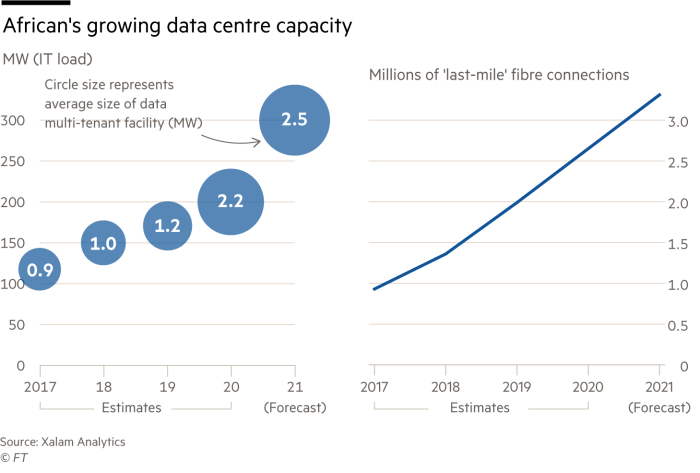
“Interoperability” across borders is also difficult. “Once you get out of these big, urban, coastal areas, to secondary cities . . . there, you still have a substantial gap,” says Mr Zibi. This includes the so-called “last mile” of getting fibre to households and businesses.
Africa saw its largest ever increase in such connections last year but even South Africa has “a significant deficit in last-mile fibre connectivity across many parts of the country”, says African Infrastructure Investment Managers, an investor which last year backed a local fibre operator to expand to cities beyond the biggest metropolitan areas.
An extreme microcosm lies off Africa’s shores. This year a special spur of the Equiano cable will join to St Helena, the remote south Atlantic outpost where Napoleon was exiled. At a minimum of 100Gb/s, according to IEEE Spectrum, it will be the fibre-optic equivalent of drinking from a gushing hose once the cable operates.
But St Helena will still need better local infrastructure to connect even a small portion of this capacity to homes and businesses — the last mile — on a 47-square-mile island.
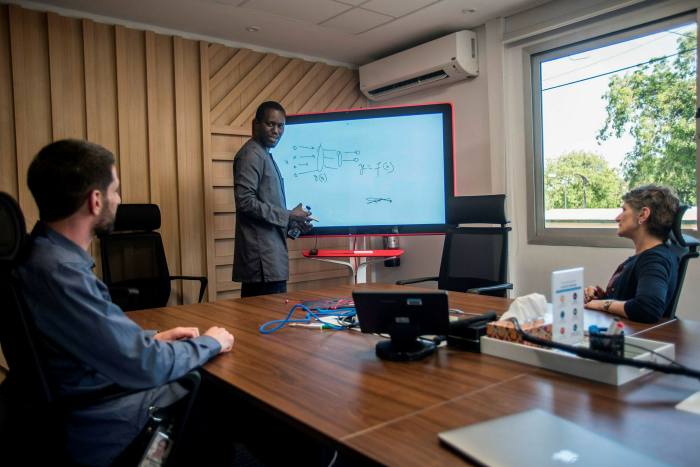
Back to the grid
The biggest block on Africa’s internet infrastructure boom might be one that has crushed many dreams of African industry catching up with the world. It is a lack of a reliable grid power.
Data centres are especially vulnerable. They promise high rates of year-round availability to customers and need to keep IT kit cooled. When grid supply fails, back-up generation can blow out operating costs. “Without cheap and reliable power, African data centres can’t be competitive, and won’t get built,” Energy for Growth Hub, a non-profit network, wrote in a recent report.
“Everyone is excited about leapfrogging,” says Rose Mutiso, a research director at Energy for Growth Hub. But “it is important to understand how infrastructure-heavy the digital economy is . . . data centres really epitomise this symbiotic role between the internet and power”.
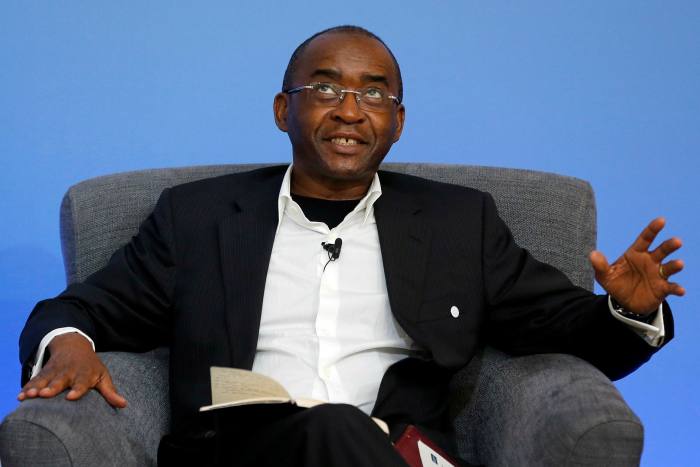
A few years ago, the IT load of the average-sized African multiple-tenant data centre was only about 0.5MW of power, according to Xalam Analytics. That level might allow diesel or batteries to generate a large portion of the electricity needed. But last year’s estimated average expanded to nearly 2MW. “Once you get past the one-megawatt threshold, it is extremely difficult to run a data centre effectively if you don’t have a reliable power grid,” says Mr Zibi.
South Africa’s grid availability for data centres is about 97 to 98 per cent — shy of the more than 99 per cent standard for uptime in developed markets, but far ahead of other African economies. This is despite regular rolling blackouts by the embattled state power monopoly, Eskom.
African utilities will need data infrastructure customers as much as the other way round, says Ms Mutiso. Kenya Power, the nation’s main supplier, “desperately needs large power users” that have stable off-peak demand in order to diversify its base of customers, she says. “The big issue in Africa’s power sector is the question of demand.”
African politicians can wax lyrical about a “fourth industrial revolution” somewhere in the cloud, but these electricity supply issues mean recognising instead that the internet is “incredibly physical” and that it will require painstaking improvements in transmission and distribution, not just generation, Ms Mutiso says. It is, she observes, “really unsexy stuff”.
Power is of course not just a problem for the back end of Africa’s growing internet. “If you can’t charge your phone, the rest becomes irrelevant,” as one Sierra Leone-based legal worker, juggling with connectivity in Freetown, puts it.
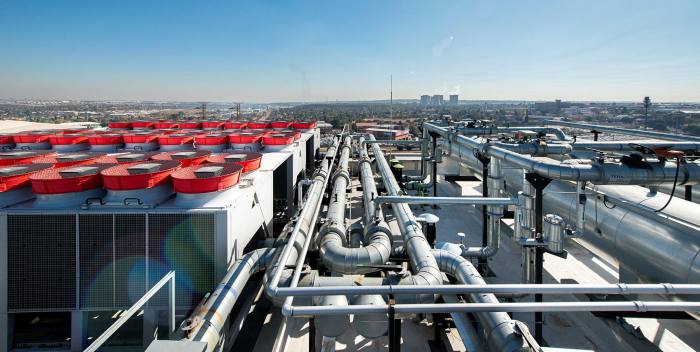
Power play
Teraco constantly upgrades the Cooling pipes and other kit on the roofs of its data centres, a sign of how fast Africa’s internet infrastructure is changing. Even with the tailwind of the pandemic’s changes to online behaviour, the race to build out Africa’s digital future will depend on politics and collaboration as well as technology. It will involve governments making policies on opening internet markets and passing laws on the use of data.
Teraco got its own start when South Africa’s telecom market liberalised about a decade ago, bringing in dozens of companies overnight. Demand for independent data centres, not tied to any carriers, took off. “Teraco filled that void,” Mr Hnizdo said.
Part of the reason for Kenya and Nigeria’s localised internet traffic explosion was that both states had at least adopted local data protection regulations by 2019. This helped give content providers confidence about parking their data locally.
In time, global power politics may overshadow the rollout of African digital infrastructure. In January, the absolute monarchy of Eswatini became the first African government to sign up to the US-backed “clean network” of countries that promise to abjure Chinese-made 5G kit — although it has reportedly since backtracked. Eswatini’s ICT ministry did not immediately respond to a request for comment.
Avoiding Huawei might be easier for Eswatini — the former Swaziland is the only African nation that still accords Taiwan diplomatic recognition. In 2019, Mr Ramaphosa blasted US “protectionism” over its blacklisting of Huawei, whose kit is critical for many South African companies’ 5G rollout.
But there is no going back. The pandemic has “definitely turbocharged not only traffic, but also the mindset — how people in marketplaces are looking at the necessity of having reliable digital infrastructure,” says Mr Zibi.
“Covid was the best example of that,” says Mr Hnizdo. “The internet and connectivity held people together. It held together our societal structures.
“It is no different to anywhere else . . . but Africa is coming off a very low base,” he adds. “It is more dramatic here.”
"last" - Google News
January 31, 2021 at 12:01PM
https://ift.tt/3ozj5IG
Cabling Africa: the great data race to serve the ‘last billion’ - Financial Times
"last" - Google News
https://ift.tt/2rbmsh7
https://ift.tt/2Wq6qvt
Bagikan Berita Ini















0 Response to "Cabling Africa: the great data race to serve the ‘last billion’ - Financial Times"
Post a Comment